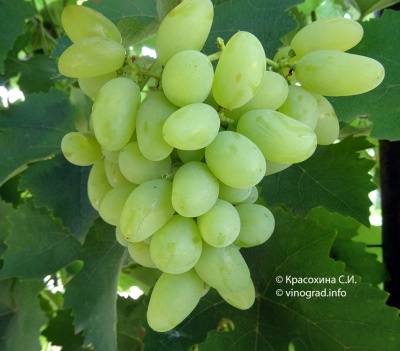
- Authors: Mr. Harada Tomikazu, Japan
- Appointment: dining room
- Berry color: amber
- Taste: with caramel and fruity tones
- With bones: Yes
- Ripening period: early
- Ripening period, days: 110-120
- Frost resistance, ° C: -23
- Bunch weight, g: 500-600
- Flower type: bisexual
For its excellent ability to store sugar, Gold Finger grapes are listed in the Guinness Book of Records. This is not the only advantage of the variety created in Japan. Asian engineering can be the star of a garden plot with proper maintenance.
Breeding history
The table grape Gold Finger appeared in 1982 as a result of crossing the Japanese breeder Harada Tomikazu (Harada Tomikazu) varieties Peerless and Pizzutello Bianco. Due to the elongated amber berries, the variety received a sonorous name. After testing at an experimental station in 1993, the hybrid was registered. Commercial success awaited the novelty. Despite the not quite suitable climate (humidity and lack of sun), competent agricultural technology allows Japanese farmers to regularly get a high yield of this variety.
Geography of distribution
Gold Finger is popular in China, where it is bred using Japanese techniques and gibberellin growth regulator. This grape variety managed to fall in love with gardeners in Russia and the CIS countries. It is successfully grown both in the Kaliningrad region and in the Kuban.
Description
It is an early high-yielding variety with a vigorous bush, conical clusters and large, very sweet berries of an original shape. It has good immunity and good frost resistance.
Ripening period
Gold Finger has early fruiting, full ripening of the berries should be expected in the second half of August. The growing season of the variety is 110-120 days.
Bunches
The shape of the brush is regular conical. The bunches are medium to large, but slightly loose, with a medium dense structure. For gardeners in Central Russia, clusters have an average weight of 500-600 g, much less often they reach 600-800 g.
Berries
Gold Finger berries are large, oval, elongated or arched, golden-milky in color, weighing from 5-6 g to 7-10 g. The skin is dense. The pulp is juicy, fleshy, aromatic. There may be 2-3 seeds inside. The sugar content is very high - from 18 to 22 degrees (Brix scale). The variety is perfect for making compotes, jams, juices, wines.
Taste
The taste of the grapes has a hint of caramel and fruity tones, without acid. When fully ripe, the berries give off a honey aroma. The rind is slightly tart.
Yield
The variety has a high yield according to its characteristics, however, it is not always possible for Russian gardeners to achieve it. The clusters of the first harvest are small, growing larger with the age of the plant.


Growing features
Gold Finger forms a tall bush, so a supporting trellis is arranged for him. It is necessary to carefully monitor the number of inflorescences on the bush, as a large number of ovaries can weaken the plant and lead to the fact that the harvest becomes poorer and the berries are smaller.This variety can be picky about watering conditions: you need warm, settled water, in which top dressing or wood ash are dissolved. When treated with phytohormones, you can get elongated seedless fruits and a more powerful vine.
Landing
Planting is done in spring or in autumn before frost. Suitable soil: loose black soil or sandy loam. Gold Finger does not tolerate drafts and prefers to grow on the sunny side. Artificial screens may be required if the area is open.
Only healthy cuttings should be selected and soaked in water. Fertilizers are poured into prepared pits (30 cm deep and 25-30 cm wide): potassium, humus, phosphorus or specialized mixtures. Grapes do not tolerate stagnant moisture, so there must be a drainage layer at the bottom of the pit. After planting, the seedling is watered, and the soil around the cutting needs to be mulched.

Pollination
The variety does not require artificial pollination: it has bisexual flowers.
Pruning
Last year's shoots are shortened as necessary, in the spring and autumn, adult bushes are regularly pruned. Grape pinching should be carried out in time when non-fruiting shoots are removed. Weak, broken branches are pruned and tied up in a timely manner. Recommended pruning length for fruit vines: 8-10 eyes.

Watering
Watering takes place in four stages:
in early spring;
before flowering;
after the formation of ovaries;
after harvest.
If the seedlings are planted in a trench, a long pipe with holes is buried in it for directional irrigation under the roots of all bushes.


Frost resistance and the need for shelter
Bushes require shelter (spunbond, agrofibre) for the winter, if the area experiences frosts with temperatures below –23 ° C. The plant is strong, and even a cold-damaged bush is restored.

Diseases and pests
Gold Finger is considered resistant to disease, but it does not hurt to apply the usual set of protective measures. The variety is highly resistant to fungal attack and is rarely attacked by pests. But wasps and birds are very fond of the sweet juice of its berries; a nylon mesh can protect them from them.

If a grape is exposed to any disease or insect, this always affects its appearance.
Storage
Ripe bunches of Gold Finger grapes have low transportability: they do not withstand long-term storage and require careful packaging.











































































